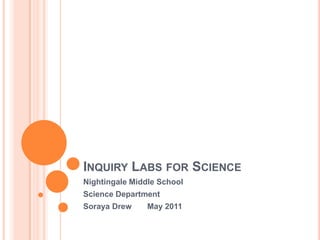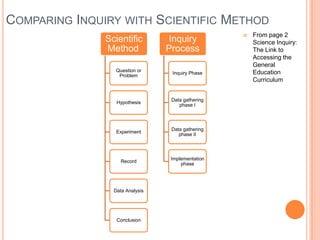Inquiry labs for science
- 1. Inquiry Labs for ScienceNightingale Middle SchoolScience DepartmentSoraya Drew May 2011
- 2. What do we do already?Brainstorm
- 3. Provided by Lisa Kramer, LD 5 Science Expert
- 4. Do inquiry based labs lead to deeper student understanding?Provided by Lisa Kramer, LD 5 Science Expert
- 5. âIn teaching him botany, he must handlethe plants and dissect the flowers forhimself: in teaching him physics andchemistry, you must not be solicitous to fill him with information, but you must be careful that what he learns he knows of his own knowledge. Donât be satisfied with telling him that a magnet attracts iron. Let him see that it does; let him feel the pull of the one upon the other for himself.â Thomas HuxleyProvided by Lisa Kramer, LD 5 Science Expert
- 6. What is inquiry?Four level model of inquiryFrom Simplifying Inquiry Instruction, The Science Teacher October 2005
- 7. Essential Features of Classroom Inquiry and Their VariationsLess Direction from Facilitator or Material------------------------------------------ More Direction from Facilitator or MaterialMore Learner Self-Direction ------------------------------------------------------------------------------ Less Learner Self-Direction
- 8. Comparing Inquiry with Scientific MethodFrom page 2 Science Inquiry: The Link to Accessing the General Education Curriculum Delve and DialogueInformation Processing: Exploring and DiscoveringPROCESSRead a selection of text and make connections to some aspect of your work. In groups, share some of your connections. Honor the spirit of inquiry with pausing, paraphrasing, and inquiring ALTERNATIVESAssign this to trios instead of a group. TIPSReview the principles of dialogue prior to starting this process. Because not listening is a common default pattern, you might want to periodically stop the action and ask people to notice what is happening in the conversation, or engage them in the Round-Robin Reflection described in this appendix.Provided by Lisa Kramer, LD 5 Science Expert
- 9. Reforming cookbook labsRead article section- we will count off to assign sections1 Students take on roles2 Mix up the steps3 Give only the procedure4 Student/teacher round-robin5 Student/student round-robin6 Data table only7 Concept Map8 Report results in paragraph form for replication9 Independent variable and dependent variable10 Only the first few steps11 Only the problem statement
- 10. Setting up labs What do you need to consider as you implement more inquiry activities?What set up in your room will help you?Think about: arrangement of desks,
- 12. how the materials are organized for the students,
- 13. how the students access the materials,
- 14. where the students work
- 15. how the lab groups are organized
- 16. how clean up occurs
- 17. your location(s)Pair ShareProvided by Lisa Kramer, LD 5 Science Expert
Editor's Notes
- #4: inquiry chart-hand out both inquiry cycle and chart from Inquiry and the National Science Education Standards-pg. 29
- #5: After revisit continuum
- #10: delve and dialog (in thinking about your reading make a connection to your classroom) to begin sharing of best practicesgo back to that visualization-what will you add










